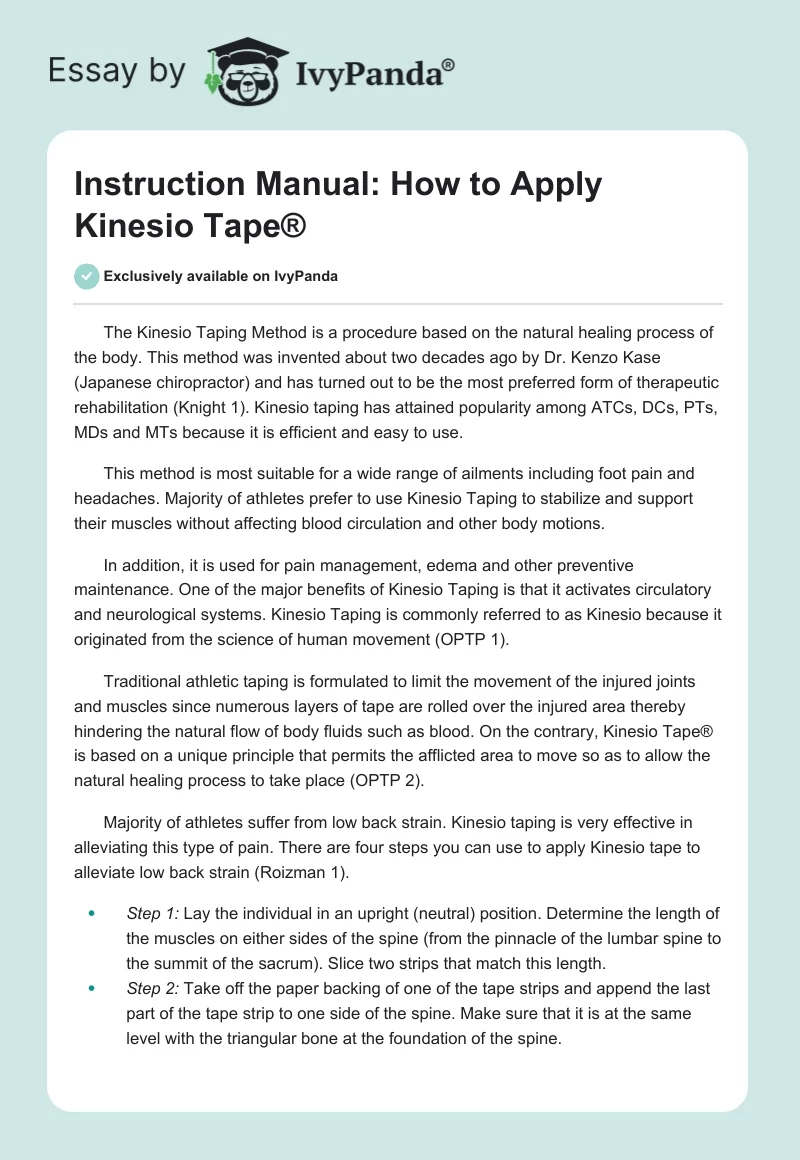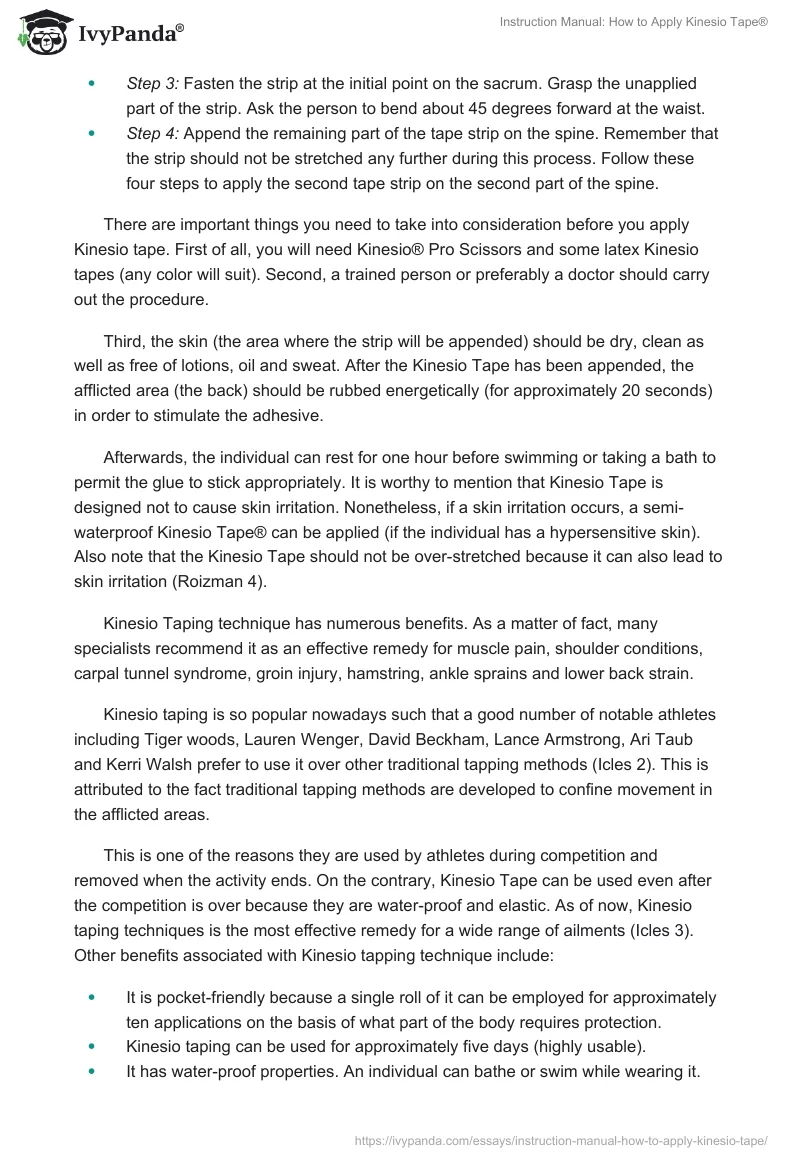The Kinesio Taping Method is a procedure based on the natural healing process of the body. This method was invented about two decades ago by Dr. Kenzo Kase (Japanese chiropractor) and has turned out to be the most preferred form of therapeutic rehabilitation (Knight 1). Kinesio taping has attained popularity among ATCs, DCs, PTs, MDs and MTs because it is efficient and easy to use.
This method is most suitable for a wide range of ailments including foot pain and headaches. Majority of athletes prefer to use Kinesio Taping to stabilize and support their muscles without affecting blood circulation and other body motions.
In addition, it is used for pain management, edema and other preventive maintenance. One of the major benefits of Kinesio Taping is that it activates circulatory and neurological systems. Kinesio Taping is commonly referred to as Kinesio because it originated from the science of human movement (OPTP 1).
Traditional athletic taping is formulated to limit the movement of the injured joints and muscles since numerous layers of tape are rolled over the injured area thereby hindering the natural flow of body fluids such as blood. On the contrary, Kinesio Tape® is based on a unique principle that permits the afflicted area to move so as to allow the natural healing process to take place (OPTP 2).
Majority of athletes suffer from low back strain. Kinesio taping is very effective in alleviating this type of pain. There are four steps you can use to apply Kinesio tape to alleviate low back strain (Roizman 1).
- Step 1: Lay the individual in an upright (neutral) position. Determine the length of the muscles on either sides of the spine (from the pinnacle of the lumbar spine to the summit of the sacrum). Slice two strips that match this length.
- Step 2: Take off the paper backing of one of the tape strips and append the last part of the tape strip to one side of the spine. Make sure that it is at the same level with the triangular bone at the foundation of the spine.
- Step 3: Fasten the strip at the initial point on the sacrum. Grasp the unapplied part of the strip. Ask the person to bend about 45 degrees forward at the waist.
- Step 4: Append the remaining part of the tape strip on the spine. Remember that the strip should not be stretched any further during this process. Follow these four steps to apply the second tape strip on the second part of the spine.
There are important things you need to take into consideration before you apply Kinesio tape. First of all, you will need Kinesio® Pro Scissors and some latex Kinesio tapes (any color will suit). Second, a trained person or preferably a doctor should carry out the procedure.
Third, the skin (the area where the strip will be appended) should be dry, clean as well as free of lotions, oil and sweat. After the Kinesio Tape has been appended, the afflicted area (the back) should be rubbed energetically (for approximately 20 seconds) in order to stimulate the adhesive.
Afterwards, the individual can rest for one hour before swimming or taking a bath to permit the glue to stick appropriately. It is worthy to mention that Kinesio Tape is designed not to cause skin irritation. Nonetheless, if a skin irritation occurs, a semi-waterproof Kinesio Tape® can be applied (if the individual has a hypersensitive skin). Also note that the Kinesio Tape should not be over-stretched because it can also lead to skin irritation (Roizman 4).
Kinesio Taping technique has numerous benefits. As a matter of fact, many specialists recommend it as an effective remedy for muscle pain, shoulder conditions, carpal tunnel syndrome, groin injury, hamstring, ankle sprains and lower back strain.
Kinesio taping is so popular nowadays such that a good number of notable athletes including Tiger woods, Lauren Wenger, David Beckham, Lance Armstrong, Ari Taub and Kerri Walsh prefer to use it over other traditional tapping methods (Icles 2). This is attributed to the fact traditional tapping methods are developed to confine movement in the afflicted areas.
This is one of the reasons they are used by athletes during competition and removed when the activity ends. On the contrary, Kinesio Tape can be used even after the competition is over because they are water-proof and elastic. As of now, Kinesio taping techniques is the most effective remedy for a wide range of ailments (Icles 3). Other benefits associated with Kinesio tapping technique include:
- It is pocket-friendly because a single roll of it can be employed for approximately ten applications on the basis of what part of the body requires protection.
- Kinesio taping can be used for approximately five days (highly usable).
- It has water-proof properties. An individual can bathe or swim while wearing it.
- Kinesio taping is not only sensitive to heat but also is acrylic-adhesive.
- The texture of Kinesio Tape® bears similar attributes to that of human skin.
- It is very elastic, latex-free and manufactured entirely using cotton.
Kinesio taping method is currently receiving numerous praise from different people around the world particularly sportsmen/sportswomen who are regularly susceptible to muscular damages as a result of strain. This technique is undoubtedly an innovative way to alleviate pain and other ailments and will remain the preferred method of relieving/alleviating pain for a long time to come. Nonetheless, Kinesio taping method is effective if the procedure is administered by a qualified person (Icles 4).
Works Cited
Icles, Bart. What Are the Benefits of the Kinesio Taping Techniques? 2009. Web.
Knight, Jim. Benefits of Kinesio Taping for Your Body. 2010. Web.
OPTP. Kinesio Taping Method. 2007. Web.
Roizman, Tracey. How to Apply Kinesio Tape. 2011. Web.


